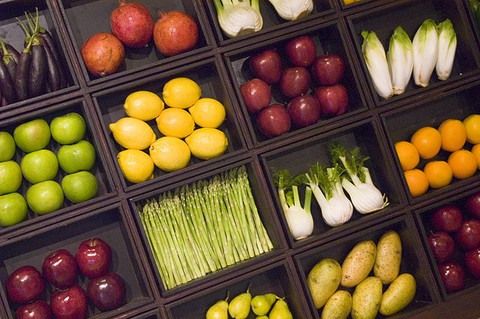 Have you heard of the Dirty Dozen? It’s the 1967 movie starring Lee Marvin, Ernest Borgnine, and Charles Bronson, where a World War II US Army Major is assigned a dozen convicted murderers to train and lead into a mass assassination mission of German officers.
Have you heard of the Dirty Dozen? It’s the 1967 movie starring Lee Marvin, Ernest Borgnine, and Charles Bronson, where a World War II US Army Major is assigned a dozen convicted murderers to train and lead into a mass assassination mission of German officers.
The modern mass assassination is even more insidious than in that old film, largely because the target is the most innocent among us: people who eat whole, real food in the form of fruits and vegetables. We know they’re good for us. Our grandmothers told us they were and the produce our grandmothers fed us WAS good for us. Usually it was grown in soils teeming with life and vital nutrients and bereft of toxic substances.
Modern agriculture has changed all that and rendered many of our most nutritious foods into enemies, largely through the application of chemical fertilizers, herbicides and pesticides. Unfortunately not all the pesticides used to kill bugs, grubs, or fungus on the factory farm wash off under the tap at home. Government tests show that many fruits and vegetables have a pesticide residue, even after washing.
Some pesticides are bred into the plant. An example is the insecticide Bt, which works by irritating insects’ stomachs. Bt is now bred into corn and there is evidence that humans may suffer from stomach ailments after eating Bt corn. A study of pigs fed GMO corn found they all suffered excess inflammation in their stomachs.
One alternative is to seek and eat organic foods but they are often appreciably more expensive than conventional produce. A good solution is to avoid the worst offenders or select organic and then buy regular versions of other produce.
Exposure to pesticides can be reduced by as much as 80% by avoiding the most contaminated foods in the grocery store, the modern Dirty Dozen, as revealed by the Environmental Working Group. Since 1995, the organization has identified which produce items have the most chemicals.
The EWG couldn’t pick just 12 so the Dirty “Dozen” is 14 for 2013.
1. Apples: In 2013, apples take the number one spot. In Michael Pollan’s book, The Botany of Desire, he explains that because we’ve lost much of the genetic diversity of apples they are disease and pest prone so the use of chemicals on them is deemed necessary. Up to 42 different chemicals are found in apples.
2. Celery: with up to 64 chemicals. Organic celery is often no more expensive than conventionally grown celery and in my experience it is far more flavourful. When I can get it on sale, I buy extra, chop it up and store it in bags in the freezer and use it in recipes where I would cook it anyway, like soups and casseroles.
3. Cherry Tomatoes: these are new on the list. It’s so unnecessary to spray tomatoes. They are among the easiest crops to grow in most climates.
4. Cucumbers: also new on the list. Also easy to grow without chemicals.
5. Grapes:
Imported grapes (grown outside USA and Canada) make the 2013 Dirty Dozen list. Vineyards can be sprayed with pesticides during different growth periods and no amount of washing or peeling will eliminate contamination. Remember, wine is made from grapes, which testing shows can harbor as many as 34 different pesticides.
6. Hot peppers: Peppers have thin skins that don’t offer much of a barrier to pesticides.
7. Nectarines (imported): Up to 33 different chemicals are found on soft-skinned nectarines, making them among the dirtiest tree fruit.
8. Peaches: up to 62 chemicals. Their soft skins make them susceptible to chemical penetration.
9. Potatoes: The Botany of Desire exposes the growing methods of potatoes and reveals that our demand for the perfectly elongated French fry is largely responsible for the monoculture that leads to the poisonous growing condition of potatoes. Potatoes can easily be grown in your home garden without chemicals.
10. Spinach: Spinach can be laced with as many as 48 different pesticides, making it one of the most contaminated green leafy vegetables.
11. Strawberries: up to 59 chemicals, especially out of season, when they’re most likely imported from countries that have less-stringent regulations for pesticide use. When organic strawberries are in season, they are often as cheap as the chemical-laden ones and their flavour is far superior.
12: Sweet Bell Peppers: May contain up to 49 different chemicals. Also thin-skinned and susceptible to absorbing chemicals.
+ Kale /collard Greens: Traditionally, kale is known as a hardier vegetable that rarely suffers from pests and disease, but it was found to have residues of organophosphates and other risky pesticides. That’s why they are on the Plus list for 2013.
+ Summer squash, domestically grown: tests found that some domestically-grown summer squash – zucchini and yellow crookneck squash — contained residues of harmful organochlorine pesticides that were phased out of agriculture in the 1970s and 1980s but that linger on some farm fields.
Incidentally, the Clean 15TM, according to the Environmental Working Group, the least contaminated produce items are Asparagus, Avocado, Cabbage, Cantaloupe, Sweet Corn, eggplant, grapefruit, Kiwi Fruit, Mango, Mushrooms, Onions, Papaya, Pineapples, Sweet Peas (Frozen), sweet potatoes.
Sources for this article include:
Environmental Working Group: http://www.ewg.org
Dirty Dozen Methodology: http://www.ewg.org/foodnews/methodology.php
http://www.NaturalNews.com
http://www.Organic.org
The Botany of Desire, by Michael Pollan





